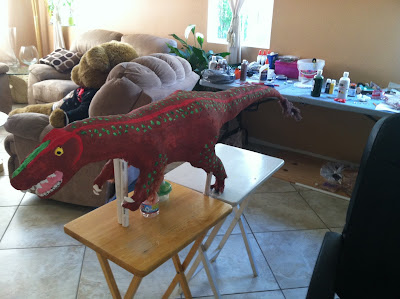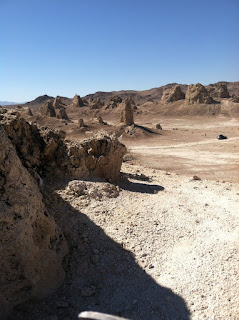| I would like to thank everyone who has helped me with my project. All the paleontologists I've met, my parents and other family members who have always pushed me to be at my best, and most of all to the senior team who pushed me out of my comfort zone with this project and in turn allowed me experience so many amazing things and to meet so many amazing and kind new people. Thank you very much! |
(1) Positive Statement
What are you most proud of in your block presentation and/or your senior project? Why?
- In terms of my presentation, I'm very proud of the set up that I had for the room and of how well I was able to walk around the classroom and just overall be interactive with my audience. The reason why I'm proud of this is because in my previous lesson presentations I had an issue with sticking behind the teachers desk, which limited how interactive I could be with my audience and I was also proud of my set up because it helped me to continually be more interactive throughout my presentation. I'm also very proud of the second independent component and mentorship that I had for my overall project because both allowed me to connect experts in the field and to widen my knowledge of what a paleontologist really does.
(2) Questions to Consider
a. What assessment would you give yourself on your block presentation? Use the component contract to defend that assessment.
- I would self evaluate that my final presentation deserves an AE. For one, I went above and beyond in my creative set up of the room I presented and not only did that set up set an atmosphere for my presentation, it also allowed me to continually be more interactive with my audience and to keep them invested in my presentation. I also related the props in my set up to what I was presenting and I think I went above and beyond with that just by having a sheer amount of props that I both brought and used. Also, I think my presentation was above average in how it kept my audience invested because I was using the pictures on my slideshow to demonstrate the majority of the points I was making with my presentation. Additionally, I think I deserve an AE on my final presentation because of how well I had my presentation memorized, since my presentation only had short bullets and not long sentences. That happened because of how well practiced I must have seemed to my audience. For all the reasons above, I think I deserve an AE for my presentation.
b. What assessment would you give yourself on your overall senior project? Use the component contract to defend that assessment.
- Overall, I think I deserve an AE on my senior project because on a vast majority of the components I've gone above what the contract called for. For example, my independent component 2 was around 70 hours. Also, my first independent component I actually traveled. Also, I went above and beyond with mentorship because even though I didn't surpass the service learning hours I think its what I had to do to earn those hours that makes that above and beyond. For example, after my mentor got his new job he and I had to put a great amount of effort into organizing when we'd meet each other and so I think in that sense I've went above and beyond for that. Also, I kept up to date with all the more smaller parts of my project like the notebook, where I took notes in color, and my blog, where I'm extremely thorough in my answers to questions like this one.
(3) What worked for you in your senior project?
- My independent components, research, blog, and my mentorship went notably well for me in my senior project.
- My independent components, research, blog, and my mentorship went notably well for me in my senior project.
(4) (What didn't work) If you had a time machine, what would you have done differently to improve your senior project?
- If I had a time machine, I'd try to improve upon my previous lesson presentations and gotten more mentorship hours and I would've also done more with my second independent component.
- If I had a time machine, I'd try to improve upon my previous lesson presentations and gotten more mentorship hours and I would've also done more with my second independent component.
(5) Finding Value
How has the senior project been helpful to you in your future endeavors? Be specific and use examples.
- One of the major issues with paleontology today has been the fact that jobs in paleontology are few and far between and that the funding for research is very rare in world that increasingly doesn't want to care for abstract fields like paleontology. I think my project has helped to prepare me for future difficulties in building up my career because throughout my project I've been introduced to many renowned experts in paleontology. My project has allowed me to network with these amazing and very kind people and I think they'd be a great source of wisdom and knowledge for me in the future and that this knowledge is going to get me through the hard times that are going to be present for me. I've also gotten to know an amazing dinosaur artist named Brian Engh and a paleontologist known as Dr. Mathew Wedel who both are renowned for their illustrative work of dinosaurs and I think they will be essential to my honing of my sculptor skills to reconstruct ancient life.
- One of the major issues with paleontology today has been the fact that jobs in paleontology are few and far between and that the funding for research is very rare in world that increasingly doesn't want to care for abstract fields like paleontology. I think my project has helped to prepare me for future difficulties in building up my career because throughout my project I've been introduced to many renowned experts in paleontology. My project has allowed me to network with these amazing and very kind people and I think they'd be a great source of wisdom and knowledge for me in the future and that this knowledge is going to get me through the hard times that are going to be present for me. I've also gotten to know an amazing dinosaur artist named Brian Engh and a paleontologist known as Dr. Mathew Wedel who both are renowned for their illustrative work of dinosaurs and I think they will be essential to my honing of my sculptor skills to reconstruct ancient life.

















































